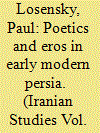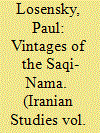| Srl | Item |
| 1 |
ID:
092947


|
|
|
|
|
| Publication |
2009.
|
| Summary/Abstract |
The poet Muhtasham K sh n? (d. 1588) is today known primarily for his strophic elegy on the martyrdom of Imam Husayn at Karbal , but such devotional poems make up only a tiny fraction of large oeuvre. Far more substantial are two works of a very different tenor, Nuql-i 'Ushsh q (The Lover's Confection) and Ris la-yi Jal liyya (The Glorious Epistle). Using an innovative combination of prose and poetry, these works tell the story of the poet-narrator's stormy affairs with, respectively, an upper-class courtesan and a footman attached to a nobleman's house. As part of the larger literary movement known as the maktab-i vuq ' or "realist school," these purported autobiographical accounts of Muhtasham's amorous adventures reveal a sophisticated culture of eros and desire that differs strikingly from the usual representations of the state of literature and the arts under Shah Tahm sp. After situating these works in their historical, literary, and cultural contexts, the article turns to a close analysis of an extended passage from each work to show how Muhtasham integrates lyric poetry, narrative, and setting to depict the pursuit of desire in the urbane world of early modern Persia
|
|
|
|
|
|
|
|
|
|
|
|
|
|
|
|
| 2 |
ID:
127785


|
|
|
|
|
| Publication |
2014.
|
| Summary/Abstract |
Drawing on a rich tradition of anacreontic poetry and taking inspiration from works by Niz?m? and H?fiz, the s?q?-n?ma or "cupbearer's song" emerged as an independent genre in the early sixteenth century and flourished throughout the Persian literary world for the next 250 years. Looking back on the development of the genre, the early seventeenth-century literary historians 'Abd al-Nab? Qazv?n? and Awhad? Baly?n? give contrasting accounts of its formation, but both agree on the significance of the work of Hak?m Partuv? Sh?r?z? (d. 928/1520-21). An examination of his s?q?-n?ma, together with two other early representatives of the genre by Sidq? Astar?b?d? (d. 952/1545) and Sharaf Jah?n Qazv?n? (d. 968/1561), shows how closely this new genre was tied to the politics and ideology of the new Safavid state and reveals profound structural similarities to the preeminent panegyric genre of the Islamicate world, the qas?da. But once the basic components of the s?q?-n?m? were distilled and taken up by poets outside this socio-political environment, the genre proved to be as protean as the wine symbolism at its core. Cupbearer songs from the end of the century, particularly those of Muhammad S?f? M?zandar?n? (d. 1035/1625-26) and Sanjar K?sh?n? (d. 1021/1612), show how the basic elements of the genre could be reconfigured to serve a variety of more personal interests.
|
|
|
|
|
|
|
|
|
|
|
|
|
|
|
|